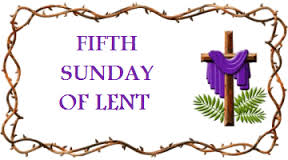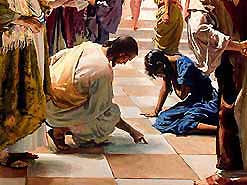
To be celebrated on 7th April 2019

Gospel reading: John 8:1-11
vs.1 Jesus went to the Mount of Olives.
vs.2 At daybreak, he appeared in the Temple again; and as all the people came to him, he sat down and began to teach them.
vs.3 The scribes and Pharisees brought a woman along who had been caught committing adultery; and making her stand there in full view of everybody,
vs.4 they said to Jesus, “Master, this woman was caught in the very act of committing adultery,
vs.5 and Moses has ordered us in the Law to condemn women like this to death by stoning. What have you to say?”
 vs.6 They asked him this as a test, looking for something to use against him. But Jesus bent down and started writing on the ground with his finger.
vs.6 They asked him this as a test, looking for something to use against him. But Jesus bent down and started writing on the ground with his finger.
vs.7 As they persisted with their question, he looked up and said, “If there is one of you who has not sinned, let him be the first to throw a stone at her.”
vs.8 Then he bent down and wrote on the ground again.
vs.9 When they heard this, they went away one by one, beginning with the eldest, until Jesus was left alone with the woman, who remained standing there.
vs.10 He looked up and said, “Woman, where are they? Has no one condemned you?”
vs.11 “No one, sir,” she replied.
“Neither do I condemn you,” said Jesus. “Go your away, and do not sin any more.”
*******************************************************
We have four commentators available from whom you may wish to choose .
Michel DeVerteuil : A Trinidadian Holy Ghost Priest, director of the Centre of Biblical renewal .
Thomas O’Loughlin: Professor of Historical Theology, University of Northampton.
Sean Goan: Studied scripture in Rome, Jerusalem and Chicago and teaches at Blackrock works with the Le Chéile School
Donal Neary SJ: Editor of The Sacred Heart Messenger
**********************************
Michel de Verteuil
Lectio Divina: The Year of Luke
www.columba.ie
General Comments
There are three people in today’s passage:
• the woman;
• the group called “scribes and Pharisees”;
• Jesus.
As always, in your meditation you must let yourself enter the story from the viewpoint of one of the three.
•The woman was guilty of a sexual sin, but her story evokes any experience of having done something shameful in a moment of great vulnerability
 •The scribes and Pharisees are typical of powerful people who have no feeling for the weak. There are several things about them that might touch you: that they have singled out this one sin for condemnation; that they are using the woman to score points against Jesus; or that they use pious phrases to mask their cruelty – all types of behaviour that are easily recognizable.
•The scribes and Pharisees are typical of powerful people who have no feeling for the weak. There are several things about them that might touch you: that they have singled out this one sin for condemnation; that they are using the woman to score points against Jesus; or that they use pious phrases to mask their cruelty – all types of behaviour that are easily recognizable.
•This picture of Jesus is one of the most touching in the gospels; look at his action of bending down and writing on the ground. It suggests tremendous inner strength which, in a non-violent way, unmasks the hypocrisy of the accusers.
Scripture reflection
“Those who live in constant terror of their own sins are powerless to accomplish anything in the world.” …Berdyaev
Lord, there was a time when the feeling of guilt had us paralyzed.
We felt condemned by voices within us:
• sermons we had heard in our childhood threatening us with hell fire;
• teachers who told us we had to be perfect.
We felt as if we were standing in full view of our accusers
and they were condemning us as deserving of death.
We thank you, Lord, that you sent us, at that moment,
a wise and kind person, who stayed with us, saying nothing,
just being there like Jesus bent down and writing on the ground,
until, very gradually, as the weeks went by,
the harsh accusing voices were silenced, one by one,
beginning from the most deeply rooted,
and eventually we were standing there knowing you were looking at us, and telling us that we were now free to go out and lead a good and creative life.
“All condemnation is of the devil. We condemn others only because we shun condemning ourselves.” …St Seraphim of Sarov
Lord, we who are community leaders in the Church or the country
often have to point out people’s faults.
Help us to do so without condemning them.
But that is not easy; we have to listen to our innermost selves,
waiting patiently until every scribe and Pharisee within us has walked away because only then do we have the right to look at another and say, “Go, and sin no more.”
Lord, just as in the time of Jesus, society pronounces its harshest judgements on those who are caught committing sexual sins, especially if they are women.
Authorities will always single them out and make them stand in full view of everybody, insisting that in the name of religion and of God, they must condemn such persons to death by stoning.
We pray, Lord, that your Church will be like Jesus, pointing out the hypocrisy of the accusers, and protecting the dignity of those who have sinned.
“One form of gentleness we should practice is towards ourselves. It is reasonable to be displeased and sorry when we commit faults, but not fretful or spiteful to ourselves.“ …St Francis de Sales.
Lord, teach us to look at ourselves with respect and compassion,
as Jesus looked at the woman taken in adultery when he was left alone with her and she remained standing before him.
Lord, send us leaders like Jesus,
who will stand with the weak and the vulnerable against their oppressors,
not aggressively, but calmly, so that the oppressors walk away of their own accord, and the weak find the space to create a good life for themselves.
 Lord, we remember a time when we were using a Bible passage to condemn someone,
Lord, we remember a time when we were using a Bible passage to condemn someone,
and quite suddenly the passage came alive for us,
and we saw that we were condemning the other for what we were guilty of ourselves,
so that we let the stone fall from our hands and went our way.
**********************************************
2.Thomas O’Loughlin,
Liturgical Resources for the Year of Luke
www.Columba.ie
Introduction to the Celebration
Today we read one of the most moving passages in the whole of the gospels: a woman, a wife who had been caught committing adultery is brought before Jesus so that he can be tested to see if he will ‘do the right thing’ and say she should be stoned. Jesus asks for the man who is not a sinner among the accusers to begin the stoning, and the group melts away one by one. Jesus does not condemn the woman for her conduct, but challenges her to begin life afresh.
 This is the challenge Jesus puts to us each Lent: begin life afresh and let others begin life afresh after they have hurt us. Let us reflect that we are all sinners, we are in need of mercy, and we need to make fresh starts.
This is the challenge Jesus puts to us each Lent: begin life afresh and let others begin life afresh after they have hurt us. Let us reflect that we are all sinners, we are in need of mercy, and we need to make fresh starts.
Gospel Notes
This little section of the four gospels has caused so much trouble to those who produce copies of New Testament (both in manuscript and in print), to exegetes, to theologians, and to preachers that it has had a special name for more than a millennium: The pericope de adultera. One thing upon which all modern scholars are agreed is that it is not part of the original gospel of John. However, if it is not part of John’s original text, it has all the signs of a genuine piece of oral tradition that circulated within the memory of the communities, especially in some churches in the West, and which subsequently embedded itself in the canonical text either at this point in John or after Lk 21:38. However, while normally such matters of textual criticism are irrelevant, here they add more complexity. Usually, omissions in manuscripts or silence among commentators indicates simply non- knowledge of the piece of text (e.g. no Greek Father or theologian before the twelfth century comments on the text, while the few Latins who do so usually provide a ‘health warning’ before doing so), but here we know that there were deliberate omissions of the text and positive refusals to preach on it before women lest they take it as indicative of the non-seriousness of adultery, (note that until the sixth century adultery, along with murder and apostasy, were seen as the greatest sins), or that men might think it subversive of good order in society. So what have we got? We have a genuine piece of early Christian tradition that was not included by any of the four canonical evangelists, but which survived and which became frozen in writing. Even though it was not too much to the liking of many, so convinced were some communities of its expression of genuine Christian tradition that they — after the appearance of the notion that genuine tradition was confined to the four canonical gospels — sought a location for the pericope either here or in Luke. The pericope’s message being at once so startling that the communities believed it represented, somehow, a core message of Jesus, yet at the same time being so shocked by it that they were embarrassed by it.
It is worth noting that there is no question in the pericope that the woman was innocent: she is guilty of the crime as charged having being caught in flagrante. The notion that Jesus saved an innocent woman is a far more palatable message; and sometimes this notion of ‘vindicated innocence’ even creeps into scholarly exegesis. Equally, there is no notion that she has to make ‘satisfaction’ as found in many medieval and modern theologies of the sacrament of penance which employ a processual model of reconciliation (the processus iustificationis), i.e. of contrition, confession, satisfaction, and absolution. The woman is not addressed about the past in any way.
Homily notes
1. The gospel does not invite a narrative, a story, or a single ‘message’; rather it demands we reflect on some very common attitudes. The homily could point out some or all of the following ‘points’. However, beware of ‘watering down’ this text as has happened so frequently: it is deeply disturbing of many attitudes common among Christians and nonChristians alike.
2. This is a text that many over the entire history of Christianity have wanted to disappear – quite literally – in that they chose not to copy it in their copies of the gospels. Moreover, when it was included in the gospel text – it is now part of the standard Greek text and has been present in the Latin text since the beginning – it was the incident that preachers and writers commented upon least frequently, at least in the period before AD 1000, and it has only become popular with preachers in the last century or so. The reasons for these objections and hesitancies are usually quite openly stated in the traditions:
first, it is socially disruptive as a husband must have leverage over his wife’s sexuality – and even if there is no stoning, then there must be some threat and warning;
second, what husband could find Christianity an acceptable religion when this gives a wife such licence – there must be a price for adultery or it brings the ‘gospel’ into disrepute;
and thirdly this seems to present Jesus as ‘soft on sin’ or on the need for penitence – this hesitation has been to the fore in recent centuries.
3. This text therefore raises the whole issue of what is Christianity about: is it a social control system or the Way to the Father who is forgiveness?
4. This text presents a male-centred universe: it is a wife who is accused, it is men who pass judgement, and it is men to see their rights/ property misused. The copyists, writers, and preachers who ignored the text or were hesitant about it, all viewed the text from the standpoint of men and the control of society.  It reminds us that Christianity emerged in a malecentred world and has in many ways colluded in that world. Just recall that no man could be stoned for adultery. This is a worldview we see challenged by Jesus – in him there is no male or female (cf Gal 4:4) – yet as our history of hesitance over this text shows, this is a part of Jesus’ proclamation that most preachers (men) have been most unwilling to take on board.
It reminds us that Christianity emerged in a malecentred world and has in many ways colluded in that world. Just recall that no man could be stoned for adultery. This is a worldview we see challenged by Jesus – in him there is no male or female (cf Gal 4:4) – yet as our history of hesitance over this text shows, this is a part of Jesus’ proclamation that most preachers (men) have been most unwilling to take on board.
5. We have to acknowledge that men and women are not treated equally in the tradition of Christianity.
6. One writer, St Ambrose (c. 339-397), did tackle the text but his concern was with the question of the death penalty: if only one without sin can throw the first stone, then can we inflict the death penalty? He recognised, even then, that the call for the death penalty arose from desires for revenge rather than for rehabilitation. This is still a major issue today where many Christians still support the notion of an eye for an eye and do not see that the Christian vision of morality is based on love, forgiveness, and helping people to start anew rather than on retribution and retaliation. So the text challenges us to see if we really believe in the call to repentance and renewal of Jesus, or whether that is something we only want for ourselves and those with us.
 7. There is no mention in the gospel of the notion of penitential reparation – she is not told to do penance but to sin no more. This silence has troubled many Catholic theologians down the centuries, especially since the Council of Trent. Do we reduce the new life that God offers us into a system of ‘paying back’ and clearing bills: this reduces reconciliation to a set of laundry lists and bills, and makes the divine mercy into a banking system of tabs and repayments.
7. There is no mention in the gospel of the notion of penitential reparation – she is not told to do penance but to sin no more. This silence has troubled many Catholic theologians down the centuries, especially since the Council of Trent. Do we reduce the new life that God offers us into a system of ‘paying back’ and clearing bills: this reduces reconciliation to a set of laundry lists and bills, and makes the divine mercy into a banking system of tabs and repayments.
8. The story exposes a basic message of the Christ: the divine mercy is greater than law.
9. Note the absolute death of the past of the woman before Jesus: ‘Go and sin no more.’ Much to the annoyance of many Christian writers there is not even a ‘stern moral word’ for the woman. Needless to say writers do not suggest that Jesus was wrong on this count; they rather suggest that in the copies to which they have access there might be something omitted! The story presents us with a past that is wholly over, and the only thing now is to start afresh. This absolute death of the past is good news.
10. In a world where people are unable to let the past be past but want to continually re-open old wounds and seek retribution and retaliation, then any new vision / life is strangled at birth.
This raises many ‘points to ponder’:
• are desires for vengeance present in our lives?
• how present is a desire to moralise?
• do we see religion as a ‘control system’?
• do we see God as mercy or the final reckoner dealing out
retribution?
• do we project a God-image of a ‘dealer of retribution’?
• how willing are we to let others let go of their past?
**********************************************
3. Sean Goan
Let the reader understand
www.columba.ie
Gospel: John 8:1-11
This Sunday we break with the gospel of Luke and take a story from the gospel of John. It has been selected because it deals with the theme of forgiveness. As with last Sunday’s gospel, so too here we see two different attitudes to the mercy of God. This time, however, it is not in a parable but in a real incident in which those with a narrow view of the mercy of God wish to use the misery of this woman as an opportunity for point scoring against Jesus. For the Pharisees, the scriptures are being read with a view to making them powerful as judges and experts in the Law. For Jesus, the scriptures are to be read as a way to understand the overwhelming mercy of God. In highlighting their hypocrisy, Jesus calls them to repentance. In highlighting God’s love for her, he calls the woman to a new life.

Reflection
‘No need to recall the past’ is the jubilant cry from the prophet in the first reading as he tells the people to look around them and discover that God is as concerned with saving them as he was with saving their ancestors in Egypt. Paul too, from his prison cell, is able to speak words that resound with hope and this is because through Jesus he has become aware of the presence of God with him in all the circumstances of his life. He can also say, ‘I forget the past because he knows that each new day offers an opportunity to come to know the love of God, a love which always triumphs over suffering and death. The woman is the gospel also discovers that she can leave the past behind because the encounter with Christ has brought her to a new day. As we draw close to Holy Week, we are invited to recognise that in the saving mystery of Easter God is always doing a new thing.
**********************************************
4. Donal Neary S.J.
Gospel reflections
www.messenger.ie/bookshop/
More than forgiveness
This is a powerful story of justice and mercy. Jesus is on the side of the woman who has been accused of sin and crime. It was an unjust accusation, and the people who brought her had little good in mind.
Jesus offers more than forgiveness – he brings mercy. Mercy forgives with compassion and doesn’t need lectures. It restores dignity to the victims of injustice like the lady in this story. It is the same in Jesus, for those who do not receive their dignity because of something they are, or something they did and are unjustly treated.

Jesus’ fiery heart of mercy
Jesus did not condemn; he turns the tables a bit. He simply says: Anyone here without sin – take the stone and throw it. Nobody does. In this atmosphere of darkness we need to hear something of the love and the mercy of God. Would light of mercy come into their darkness of condemnation? Would they leave their darkness into a personal space where they might have a change of heart?
This is also about the challenge to live honestly and without sin; and to be able to takes steps like this woman’s life, to move on. All hear this word from Jesus – I do not condemn you. This comes to our society and to ourselves. We need to hear this word for ourselves as often we throw stones at ourselves more than at others. What we condemn in others is what sometimes we do not like in ourselves.
Lord may we enter this world of mercy wherever we need to.
May we hear these words always, ‘I do not condemn you’
For Video resources for Lent: please click here https://www.catholicireland.net/lent-videos